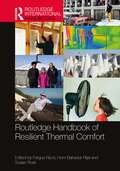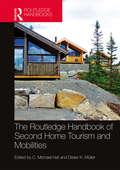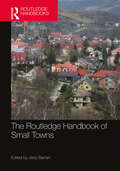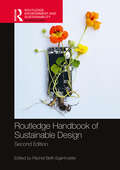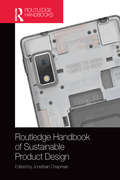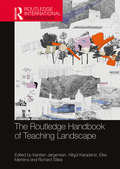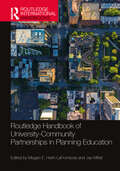- Table View
- List View
Routledge Handbook of Resilient Thermal Comfort (Routledge International Handbooks)
by Fergus NicolThis book brings together some of the finest academics in the field to address important questions around the way in which people experience their physical environments, including temperature, light, air-quality, acoustics and so forth. It is of importance not only to the comfort people feel indoors, but also the success of any building as an environment for its stated purpose. The way in which comfort is produced and perceived has a profound effect on the energy use of a building and its resilience to the increasing dangers posed by extreme weather events, and power outages caused by climate change. Research on thermal comfort is particularly important not only for the health and well-being of occupants but because energy used for temperature control is responsible for a large part of the total energy budget of the built environment. In recent years there has been an increasing focus on the vulnerabilities of the thermal comfort system; how and why are buildings failing to provide safe and agreeable thermal environments at an affordable price? Achieving comfort in buildings is a complex subject that involves physics, behaviour, physiology, energy conservation, climate change, and of course architecture and urban design. Bringing together the related disciplines in one volume lays strong, multi-disciplinary foundations for new research and design directions for resilient 21st century architecture. This book heralds workable solutions and emerging directions for key fields in building the resilience of households, organisations and populations in a heating world.
Routledge Handbook of Resilient Thermal Comfort (Routledge International Handbooks)
by Fergus Nicol Hom Bahadur Rijal Susan RoafThis book brings together some of the finest academics in the field to address important questions around the way in which people experience their physical environments, including temperature, light, air-quality, acoustics and so forth. It is of importance not only to the comfort people feel indoors, but also the success of any building as an environment for its stated purpose. The way in which comfort is produced and perceived has a profound effect on the energy use of a building and its resilience to the increasing dangers posed by extreme weather events, and power outages caused by climate change. Research on thermal comfort is particularly important not only for the health and well-being of occupants but because energy used for temperature control is responsible for a large part of the total energy budget of the built environment. In recent years there has been an increasing focus on the vulnerabilities of the thermal comfort system; how and why are buildings failing to provide safe and agreeable thermal environments at an affordable price? Achieving comfort in buildings is a complex subject that involves physics, behaviour, physiology, energy conservation, climate change, and of course architecture and urban design. Bringing together the related disciplines in one volume lays strong, multi-disciplinary foundations for new research and design directions for resilient 21st century architecture. This book heralds workable solutions and emerging directions for key fields in building the resilience of households, organisations and populations in a heating world.
Routledge Handbook of Seascapes (Routledge Environment and Sustainability Handbooks)
by Gloria PungettiSeascape studies have developed in response to questions arising from composite correlations such as coastal, island and marine research, social requirements, landscape design and planning, marine ecology, and environment and resource management. This global volume is the first comprehensive overview to provide a solid foundation on the concept of seascape, with the latest research findings from leading experts across a variety of fields, offering a holistic approach to seascape linking nature with culture, and theory with practice. Divided into six parts, it includes over 30 chapters from contributors around the world. Pioneering methods with illustrated case studies from the Mediterranean, Scandinavia, North Sea, North America and Asia serve as examples for future seascape development, conservation and governance. An important and extremely timely resource, the Routledge Handbook of Seascapes provides academics, practitioners, NGOs, consultants and government officials with a broad overview of current research and practice for future application and advance worldwide.
Routledge Handbook of Seascapes (Routledge Environment and Sustainability Handbooks)
by Gloria PungettiSeascape studies have developed in response to questions arising from composite correlations such as coastal, island and marine research, social requirements, landscape design and planning, marine ecology, and environment and resource management. This global volume is the first comprehensive overview to provide a solid foundation on the concept of seascape, with the latest research findings from leading experts across a variety of fields, offering a holistic approach to seascape linking nature with culture, and theory with practice. Divided into six parts, it includes over 30 chapters from contributors around the world. Pioneering methods with illustrated case studies from the Mediterranean, Scandinavia, North Sea, North America and Asia serve as examples for future seascape development, conservation and governance. An important and extremely timely resource, the Routledge Handbook of Seascapes provides academics, practitioners, NGOs, consultants and government officials with a broad overview of current research and practice for future application and advance worldwide.
The Routledge Handbook of Second Home Tourism and Mobilities
by C. Michael Hall Dieter MüllerSecond homes have become an increasingly important component of both tourism and housing studies. They can directly and indirectly contribute a significant number of domestic and international visitors to destinations and may be part of longer-term retirement, lifestyle and amenity migration that can have significant economic and social effects on communities and destination development. This volume offers an overview of different disciplinary and methodological approaches to second homes while simultaneously providing a broad geographical reach. Divided into four parts exploring governance, development, community and mobile second homes, the book provides a contemporary account of the major issues in an area of growing international interest. This timely handbook covers a wide range of dimensions – from planning to the role of second homes in development and the management of their impact. The international and cross-disciplinary nature of the contributions will be of interest to numerous academic fields in the social sciences, as well as urban and regional planners.
The Routledge Handbook of Second Home Tourism and Mobilities
by C. Michael Hall Dieter K. MüllerSecond homes have become an increasingly important component of both tourism and housing studies. They can directly and indirectly contribute a significant number of domestic and international visitors to destinations and may be part of longer-term retirement, lifestyle and amenity migration that can have significant economic and social effects on communities and destination development. This volume offers an overview of different disciplinary and methodological approaches to second homes while simultaneously providing a broad geographical reach. Divided into four parts exploring governance, development, community and mobile second homes, the book provides a contemporary account of the major issues in an area of growing international interest. This timely handbook covers a wide range of dimensions – from planning to the role of second homes in development and the management of their impact. The international and cross-disciplinary nature of the contributions will be of interest to numerous academic fields in the social sciences, as well as urban and regional planners.
The Routledge Handbook of Small Towns
by Jerzy Ba 324 SkiThe Routledge Handbook of Small Towns addresses the theoretical, methodical, and practical issues related to the development of small towns and neighbouring countryside. Small towns play a very important role in spatial structure by performing numerous significant developmental functions for rural areas. At the local scale, they act as engines for economic growth of rural regions and as a link in the system of connections between large urban centres and the countryside. The book addresses the role of small towns in the local development of regions in countries with different levels of development and economic systems, including those in Europe, Africa, South America, Asia, and Australia. Chapters address the functional structure of small towns, relations between small towns and rural areas, and the challenges of spatial planning in the context of shaping the development of small towns. Students and scholars of urban planning, urban geography, rural geography, political geography, historical geography, and population geography will learn about the role of small towns in the local development of countries representing different economic systems and developmental conditions.
The Routledge Handbook of Small Towns
by Jerzy BańskiThe Routledge Handbook of Small Towns addresses the theoretical, methodical, and practical issues related to the development of small towns and neighbouring countryside. Small towns play a very important role in spatial structure by performing numerous significant developmental functions for rural areas. At the local scale, they act as engines for economic growth of rural regions and as a link in the system of connections between large urban centres and the countryside. The book addresses the role of small towns in the local development of regions in countries with different levels of development and economic systems, including those in Europe, Africa, South America, Asia, and Australia. Chapters address the functional structure of small towns, relations between small towns and rural areas, and the challenges of spatial planning in the context of shaping the development of small towns. Students and scholars of urban planning, urban geography, rural geography, political geography, historical geography, and population geography will learn about the role of small towns in the local development of countries representing different economic systems and developmental conditions.
Routledge Handbook of Sport and Legacy: Meeting the Challenge of Major Sports Events (Routledge International Handbooks)
by Dino Ruta Richard HoltWhat remains of a great sporting spectacle after the last race is run or the final match is played? How can the vast expense of mounting such events be justified? What if there is nothing left behind or what if the legacy is negative, a costly infrastructure which is unused or a debt-ridden host city? The Routledge Handbook of Sport and Legacy addresses perhaps the most important issue in the hosting of major contemporary sporting events: the problem of ‘legacy’. It offers a rigorous, innovative and comparative insight into this contested concept from interdisciplinary and practical perspectives. Major events must now have a conscious, credible and defined policy for legacy to meet public expectations. The book provides a comprehensive survey of the various kinds of legacy that can be delivered, as well as a close examination of the potential benefits and practical challenges involved in each. From ‘hard’ legacies, such as stadia and infrastructure, to ‘soft’ legacies including skill development, attitude change and capacity building, the book offers both a historical case study and an innovative strategic management approach, and establishes the limits of what can realistically be achieved in terms of economic, social, cultural, physical and sporting development. The Routledge Handbook of Sport and Legacy includes contributions from world leading scholars and practitioners and features detailed case studies of major sports events from around the world, including the FIFA World Cup and ten Olympics Games from London in 1908 to London 2012. It is invaluable reading for students and researchers working in sport studies, events management, human geography, economics or planning, and an essential reference for any professional engaged in delivering legacy through sport.
Routledge Handbook of Sport and Legacy: Meeting the Challenge of Major Sports Events (Routledge International Handbooks)
by Dino Ruta Richard HoltWhat remains of a great sporting spectacle after the last race is run or the final match is played? How can the vast expense of mounting such events be justified? What if there is nothing left behind or what if the legacy is negative, a costly infrastructure which is unused or a debt-ridden host city? The Routledge Handbook of Sport and Legacy addresses perhaps the most important issue in the hosting of major contemporary sporting events: the problem of ‘legacy’. It offers a rigorous, innovative and comparative insight into this contested concept from interdisciplinary and practical perspectives. Major events must now have a conscious, credible and defined policy for legacy to meet public expectations. The book provides a comprehensive survey of the various kinds of legacy that can be delivered, as well as a close examination of the potential benefits and practical challenges involved in each. From ‘hard’ legacies, such as stadia and infrastructure, to ‘soft’ legacies including skill development, attitude change and capacity building, the book offers both a historical case study and an innovative strategic management approach, and establishes the limits of what can realistically be achieved in terms of economic, social, cultural, physical and sporting development. The Routledge Handbook of Sport and Legacy includes contributions from world leading scholars and practitioners and features detailed case studies of major sports events from around the world, including the FIFA World Cup and ten Olympics Games from London in 1908 to London 2012. It is invaluable reading for students and researchers working in sport studies, events management, human geography, economics or planning, and an essential reference for any professional engaged in delivering legacy through sport.
Routledge Handbook of Sustainability and Fashion (Routledge International Handbooks)
by Kate Fletcher Mathilda ThamThe clothing industry employs 25 million people globally contributing to many livelihoods and the prosperity of communities, to women’s independence, and the establishment of significant infrastructures in poorer countries. Yet the fashion industry is also a significant contributor to the degradation of natural systems, with the associated environmental footprint of clothing high in comparison with other products. Routledge Handbook of Sustainability and Fashion recognizes the complexity of aligning fashion with sustainability. It explores fashion and sustainability at the levels of products, processes, and paradigms and takes a truly multi-disciplinary approach to critically question and suggest creative responses to issues of:• Fashion in a post-growth society • Fashion, diversity and equity • Fashion, fluidity and balance across natural, social and economic systems This handbook is a unique resource for a wide range of scholars and students in the social sciences, arts and humanities interested in sustainability and fashion.
Routledge Handbook of Sustainability and Fashion (Routledge International Handbooks)
by Kate Fletcher Mathilda ThamThe clothing industry employs 25 million people globally contributing to many livelihoods and the prosperity of communities, to women’s independence, and the establishment of significant infrastructures in poorer countries. Yet the fashion industry is also a significant contributor to the degradation of natural systems, with the associated environmental footprint of clothing high in comparison with other products. Routledge Handbook of Sustainability and Fashion recognizes the complexity of aligning fashion with sustainability. It explores fashion and sustainability at the levels of products, processes, and paradigms and takes a truly multi-disciplinary approach to critically question and suggest creative responses to issues of:• Fashion in a post-growth society • Fashion, diversity and equity • Fashion, fluidity and balance across natural, social and economic systems This handbook is a unique resource for a wide range of scholars and students in the social sciences, arts and humanities interested in sustainability and fashion.
The Routledge Handbook of Sustainable Cities and Landscapes in the Pacific Rim (Routledge Environment and Sustainability Handbooks)
by Yizhao YangThis handbook addresses a growing list of challenges faced by regions and cities in the Pacific Rim, drawing connections around the what, why, and how questions that are fundamental to sustainable development policies and planning practices. These include the connection between cities and surrounding landscapes, across different boundaries and scales; the persistence of environmental and development inequities; and the growing impacts of global climate change, including how physical conditions and social implications are being anticipated and addressed. Building upon localized knowledge and contextualized experiences, this edited collection brings attention to place-based approaches across the Pacific Rim and makes an important contribution to the scholarly and practical understanding of sustainable urban development models that have mostly emerged out of the Western experiences. Nine sections, each grounded in research, dialogue, and collaboration with practical examples and analysis, focus on a theme or dimension that carries critical impacts on a holistic vision of city-landscape development, such as resilient communities, ecosystem services and biodiversity, energy, water, health, and planning and engagement. This international edited collection will appeal to academics and students engaged in research involving landscape architecture, architecture, planning, public policy, law, urban studies, geography, environmental science, and area studies. It also informs policy makers, professionals, and advocates of actionable knowledge and adoptable ideas by connecting those issues with the Sustainable Development Goals (SDGs) of the United Nations. The collection of writings presented in this book speaks to multiyear collaboration of scholars through the APRU Sustainable Cities and Landscapes (SCL) Program and its global network, facilitated by SCL Annual Conferences and involving more than 100 contributors from more than 30 institutions.
The Routledge Handbook of Sustainable Cities and Landscapes in the Pacific Rim (Routledge Environment and Sustainability Handbooks)
by Yizhao Yang Anne TaufenThis handbook addresses a growing list of challenges faced by regions and cities in the Pacific Rim, drawing connections around the what, why, and how questions that are fundamental to sustainable development policies and planning practices. These include the connection between cities and surrounding landscapes, across different boundaries and scales; the persistence of environmental and development inequities; and the growing impacts of global climate change, including how physical conditions and social implications are being anticipated and addressed. Building upon localized knowledge and contextualized experiences, this edited collection brings attention to place-based approaches across the Pacific Rim and makes an important contribution to the scholarly and practical understanding of sustainable urban development models that have mostly emerged out of the Western experiences. Nine sections, each grounded in research, dialogue, and collaboration with practical examples and analysis, focus on a theme or dimension that carries critical impacts on a holistic vision of city-landscape development, such as resilient communities, ecosystem services and biodiversity, energy, water, health, and planning and engagement. This international edited collection will appeal to academics and students engaged in research involving landscape architecture, architecture, planning, public policy, law, urban studies, geography, environmental science, and area studies. It also informs policy makers, professionals, and advocates of actionable knowledge and adoptable ideas by connecting those issues with the Sustainable Development Goals (SDGs) of the United Nations. The collection of writings presented in this book speaks to multiyear collaboration of scholars through the APRU Sustainable Cities and Landscapes (SCL) Program and its global network, facilitated by SCL Annual Conferences and involving more than 100 contributors from more than 30 institutions.
Routledge Handbook of Sustainable Design (Routledge International Handbooks)
by Rachel Beth EgenhoeferThe Routledge Handbook of Sustainable Design considers the design, not only of artifacts, but of structures, systems, and interactions that bear our decisions and identities in the context of sustaining our shared planet. In addressing issues of design for global impact, behavior change, systems and strategy, ethics and values, this handbook presents a unique and powerful design perspective. Just as there are multiple definitions of design, so there are several definitions of sustainability, making it difficult to find unity. The term can sometimes be seen as a goal to achieve, or a characteristic to check off on a list of criteria. In actuality, we will never finish being sustainable. We must instead always strive to design, work, and live sustainably. The voices throughout this handbook present many different characteristics, layers, approaches, and perspectives in this journey of sustaining. This handbook divides into five sections, which together present a holistic approach to understanding the many facets of sustainable design: Part 1: Systems and Design Part 2: Global Impact Part 3: Values, Ethics, and Identity Part 4: Design for Behavior Change Part 5: Moving Forward This handbook will be invaluable to those wishing to broaden their understanding of sustainable design and students and practitioners of Environmental Studies, Architecture, Product Design and the Visual Arts.
Routledge Handbook of Sustainable Design (Routledge International Handbooks)
by Rachel Beth EgenhoeferThe Routledge Handbook of Sustainable Design considers the design, not only of artifacts, but of structures, systems, and interactions that bear our decisions and identities in the context of sustaining our shared planet. In addressing issues of design for global impact, behavior change, systems and strategy, ethics and values, this handbook presents a unique and powerful design perspective. Just as there are multiple definitions of design, so there are several definitions of sustainability, making it difficult to find unity. The term can sometimes be seen as a goal to achieve, or a characteristic to check off on a list of criteria. In actuality, we will never finish being sustainable. We must instead always strive to design, work, and live sustainably. The voices throughout this handbook present many different characteristics, layers, approaches, and perspectives in this journey of sustaining. This handbook divides into five sections, which together present a holistic approach to understanding the many facets of sustainable design: Part 1: Systems and Design Part 2: Global Impact Part 3: Values, Ethics, and Identity Part 4: Design for Behavior Change Part 5: Moving Forward This handbook will be invaluable to those wishing to broaden their understanding of sustainable design and students and practitioners of Environmental Studies, Architecture, Product Design and the Visual Arts.
Routledge Handbook of Sustainable Design (Routledge Environment and Sustainability Handbooks)
by Rachel Beth EgenhoeferThe Routledge Handbook of Sustainable Design considers the design, not only of artifacts, but of structures, systems, and interactions in the context of sustaining our shared planet. This revised edition introduces new and updated chapters, as well as a new section on pedagogy for sustainable design. With authors from around the world, design is positioned in context with recent crises such as global pandemics, racial reckoning, political unrest, and natural disasters. Just as design is an interdisciplinary field, the climate crisis is deeply tangled in racial justice, gender justice, global health, economics, trade, and more. Divided into six sections, it presents a holistic approach to understanding the many facets of sustainable design: Part 1: Systems and Design Part 2: Complexities of Sustainable Design Part 3: Community Engaged Design for Local and Global Diversity Part 4: Design for Sustainable Behaviors Part 5: Design Futures Part 6: Pedagogy in Design for Sustainability Arguing that design needs to restore, regenerate, and rejuvenate our planet and people, this handbook will be invaluable to researchers, students, and practitioners across all subdisciplines of design, architecture, business, energy management, visual arts, and environmental studies, among others.
Routledge Handbook of Sustainable Design (Routledge Environment and Sustainability Handbooks)
by Rachel Beth EgenhoeferThe Routledge Handbook of Sustainable Design considers the design, not only of artifacts, but of structures, systems, and interactions in the context of sustaining our shared planet. This revised edition introduces new and updated chapters, as well as a new section on pedagogy for sustainable design. With authors from around the world, design is positioned in context with recent crises such as global pandemics, racial reckoning, political unrest, and natural disasters. Just as design is an interdisciplinary field, the climate crisis is deeply tangled in racial justice, gender justice, global health, economics, trade, and more. Divided into six sections, it presents a holistic approach to understanding the many facets of sustainable design: Part 1: Systems and Design Part 2: Complexities of Sustainable Design Part 3: Community Engaged Design for Local and Global Diversity Part 4: Design for Sustainable Behaviors Part 5: Design Futures Part 6: Pedagogy in Design for Sustainability Arguing that design needs to restore, regenerate, and rejuvenate our planet and people, this handbook will be invaluable to researchers, students, and practitioners across all subdisciplines of design, architecture, business, energy management, visual arts, and environmental studies, among others.
Routledge Handbook of Sustainable Product Design
by Jonathan ChapmanAs a cultivated form of invention, product design is a deeply human phenomenon that enables us to shape, modify and alter the world around us – for better or worse. The recent emergence of the sustainability imperative in product design compels us to recalibrate the parameters of good design in an unsustainable age. Written by designers, for designers, the Routledge Handbook of Sustainable Product Design presents the first systematic overview of the burgeoning field of sustainable product design. Brimming with intelligent viewpoints, critical propositions, practical examples and rich theoretical analyses, this book provides an essential point of reference for scholars and practitioners at the intersection of product design and sustainability. The book takes readers to the depth of our engagements with the designed world to advance the social and ecological purpose of product design as a critical twenty-first-century practice. Comprising 35 chapters across 6 thematic parts, the book’s contributors include the most significant international thinkers in this dynamic and evolving field.
Routledge Handbook of Sustainable Product Design
by Jonathan ChapmanAs a cultivated form of invention, product design is a deeply human phenomenon that enables us to shape, modify and alter the world around us – for better or worse. The recent emergence of the sustainability imperative in product design compels us to recalibrate the parameters of good design in an unsustainable age. Written by designers, for designers, the Routledge Handbook of Sustainable Product Design presents the first systematic overview of the burgeoning field of sustainable product design. Brimming with intelligent viewpoints, critical propositions, practical examples and rich theoretical analyses, this book provides an essential point of reference for scholars and practitioners at the intersection of product design and sustainability. The book takes readers to the depth of our engagements with the designed world to advance the social and ecological purpose of product design as a critical twenty-first-century practice. Comprising 35 chapters across 6 thematic parts, the book’s contributors include the most significant international thinkers in this dynamic and evolving field.
The Routledge Handbook of Teaching Landscape (Routledge International Handbooks)
by Karsten Jørgensen Nilgül Karadeniz Elke Mertens Richard StilesWritten in collaboration with the European Council of Landscape Architecture Schools (ECLAS) and LE: NOTRE, The Routledge Handbook of Teaching Landscape provides a wide-ranging overview of teaching landscape subjects, from geology to landscape design, reflecting different perspectives and practices at university-level landscape curricula. Focusing on the didactics of landscape education, this fully illustrated handbook presents and discusses pedagogy, teaching traditions, experimental teaching methods and new teaching principles. The book is structured into three parts: reading the landscape, representing the landscape and transforming the landscape. Contributions from leading experts in the field, such as Simon Bell, Marc Treib, Jörg Rekittke and Susan Herrington, explore landscape analysis, history and theory, design visualisation, creativity and art, planning studio teaching, field trips and site engineering. Aimed at engaging academic researchers and instructors across disciplines such as landscape architecture, geography, ecology, planning and archaeology, this book is a must-have guide to landscape pedagogy as it stands today.
The Routledge Handbook of Teaching Landscape (Routledge International Handbooks)
Written in collaboration with the European Council of Landscape Architecture Schools (ECLAS) and LE: NOTRE, The Routledge Handbook of Teaching Landscape provides a wide-ranging overview of teaching landscape subjects, from geology to landscape design, reflecting different perspectives and practices at university-level landscape curricula. Focusing on the didactics of landscape education, this fully illustrated handbook presents and discusses pedagogy, teaching traditions, experimental teaching methods and new teaching principles. The book is structured into three parts: reading the landscape, representing the landscape and transforming the landscape. Contributions from leading experts in the field, such as Simon Bell, Marc Treib, Jörg Rekittke and Susan Herrington, explore landscape analysis, history and theory, design visualisation, creativity and art, planning studio teaching, field trips and site engineering. Aimed at engaging academic researchers and instructors across disciplines such as landscape architecture, geography, ecology, planning and archaeology, this book is a must-have guide to landscape pedagogy as it stands today.
Routledge Handbook of Transportation
by Dušan TeodorovićThe Routledge Handbook of Transportation offers a current and comprehensive survey of transportation planning and engineering research. It provides a step-by-step introduction to research related to traffic engineering and control, transportation planning, and performance measurement and evaluation of transportation alternatives. The Handbook of Transportation demonstrates models and methods for predicting travel and freight demand, planning future transportation networks, and developing traffic control systems. Readers will learn how to use various engineering concepts and approaches to make future transportation safer, more efficient, and more sustainable. Edited by Dušan Teodorović and featuring 29 chapters from more than 50 leading global experts, with more than 200 illustrations, the Routledge Handbook of Transportation is designed as an invaluable resource for professionals and students in transportation planning and engineering.
Routledge Handbook of Transportation
by Dusan TeodorovicThe Routledge Handbook of Transportation offers a current and comprehensive survey of transportation planning and engineering research. It provides a step-by-step introduction to research related to traffic engineering and control, transportation planning, and performance measurement and evaluation of transportation alternatives. The Handbook of Transportation demonstrates models and methods for predicting travel and freight demand, planning future transportation networks, and developing traffic control systems. Readers will learn how to use various engineering concepts and approaches to make future transportation safer, more efficient, and more sustainable. Edited by Dušan Teodorović and featuring 29 chapters from more than 50 leading global experts, with more than 200 illustrations, the Routledge Handbook of Transportation is designed as an invaluable resource for professionals and students in transportation planning and engineering.
Routledge Handbook of University-Community Partnerships in Planning Education (Routledge International Handbooks)
by Heim LaFrombois, Megan E. Jay MittalThis handbook explores two guiding questions – how can university-community partnerships in planning education work, and how can they be transformative? University-community partnerships – often referred to as service-learning or community-engaged teaching and learning – are traditionally based on a collaborative relationship between an academic partner and a community-based partner, in which students from the academic partner work within the community on a project. Transformational approaches to university-community partnerships are approaches that develop and sustain mutually beneficial collaborations where knowledge is co-created and new ways of knowing and doing are discovered. This edited volume examines a variety of university-community partnerships in planning education, from a number of different perspectives, with a focus on transformative models. The authors explore broader theoretical issues, including topics relating to pedagogy, planning theory, and curriculum; along with more practical topics relating to best practices, logistics, institutional support, outcome measures, and the various forms these partnerships can take – all through an array of case studies. The authors, which include academics, professional practitioners, academic practitioners, and students, bring an incredible depth and breadth of knowledge and experience from across the globe – Australia, Canada, Chile, Europe (including Germany, Spain, Slovakia, and Sweden), India, Jamaica, South Korea, and the United States.
